Gridley class destroyers (1937-1947)
 USN Fleet Destroyers (1912-1935): USS Gridley, Craven, McCall, Maury (DD-380-401)
USN Fleet Destroyers (1912-1935): USS Gridley, Craven, McCall, Maury (DD-380-401)
The Gridley-class destroyers were four 1500-ton fleet destroyers according to the London Naval Treaty, laid down by June 1935 and March 1936, commissioned in 1937-38 and largely based on the previous Mahan-class destroyers: Same hull but single stack and reviewed powerplant, for greater speeds and an amazing sixteen 21 inch (533 mm) torpedo tubes arrangement but reduced artillery. They inaugurated a famous trio of 22 identical destroyers (with the Bagleys and Benhams). USS Maury (DD-401) became the fastest #USN destroyer at 42.8 knots. They were all very active in #WW2, seeing most battles and operations of the Pacific, notably escorting carriers. USS Maury receiving a Presidential Unit Citation and the class earning collectively 44 battle stars. #pacificwar #guadalcanal
Design of the class
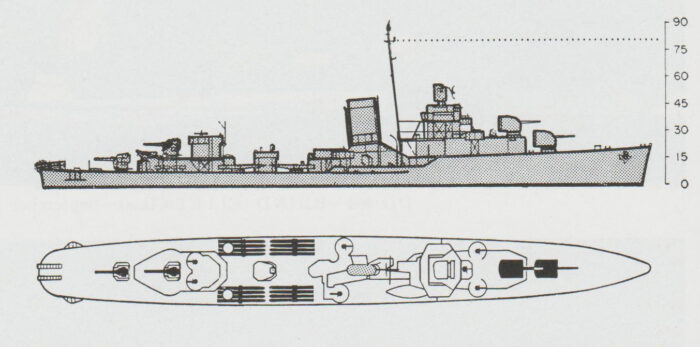
ONI schematics showing the position of the torpedo tubes banks.
A record sixteen torpedo tubes
The four Gridleys proceeded from the idea of gradually improving the Mahan class design. They were were part of three classes sharing the same characteristics, laid down in 1935-1937, and each with small incremental improvements: Gridley (4, the “prototypes”), Bagley (8 ships) and Benham (10 ships). They all favored a massive torpedo armament in response to the Japanese “special types”, destined to give them an advantage in broadside. But the cost was to loose their five guns, reduced to four 5 inch (127 mm) (which was by the way the European standard for this 1500 tons class of ships). However the main reason behind this moved can be seen as the preception in the admiralty that the last nine of the seventeen US Treaty cruisers lacked torpedo armament. On the long run anyway, eventually all these torpedoes were removed in 1941 for increased AA.
If BuOrd (The bureau of Ordnance) had no counter-indications to swap to four quadruple mounts for a destroyer, this was a sheer amount, in stark contrast with the late wartime destroyers designs, which returned to just two axial banks, albeit quintuple. Having four axial banks was the ideal solution but impossible due to the hull’s lenght and displacement, the Bureau of Construction and Repair (BuC&R) and the Bureau of Engineering (BuEng) teamed up to find another variant of the solution already tested on the previous Mahans, which had a single axial bank and two side banks.
This was just the next logical step: Putting all four banks in broadsides. In practice, this allowed to bring the superstructure amidships loser together, leaving empty room to allow the banks to freely rotate to their max traverse and procure the greatest possible arc of fire. Still, these prevented the opposite side banks to fire the other side. There were also blocking gears to prevent firing onto the structure or interfere with other banks. By the way this formula was not new of course: It was already chosen for the mass-built WWI “four-pipers” of the Wickes and Clemson class, but with triple banks. A larger beam allowed for quadruple ones.
The other particular was that the two banks port and starboard were facing each other rather than outwards.
Of course, if on one hand these destroyers had largest number of torpedo tubes, impressive on paper, their actual broadside was only the same as any destroyer of the time, at least in Europe. Japanese DDs had three axial banks. They had no reloads abnd traded these for a complete U-turn to fire the other broadside. A destroyer tactic was based around this. The broadside arrangement (not unique to US destroyer, the French did the same on their large “super destroyers” of the Terrible and Mogador classes.
A new step in US Destroyer Design evolution
As usual the other playground for the Bureaus and the admiralty board was to compare machinery arrangements. The Gridleys were designed by Bethlehem Shipbuilding Co., and the latter proposed advanced high-pressure boilers, built by them, but married to essentially the same geared steam turbines used on the 1933 Farragut class. This had an afverse effect on their range. The following Bagleys at the contrary duplicated the Mahan class machinery. The Benhams were designed by NY agency Gibbs & Cox, the same team behing the Mahan class design advanced machinery. But they had a new boiler type allowing a reduction from four to three and the same efficient turbine arrangement as the Mahans class.
So in a nutshell, the Gridleys were seen as rather “conservative” and leaning more on the Farraguts, with just better boilers and a single funnel, but twice as much torpedoes. The latter was a caracteristic shared by all three designs, but the next Sims class, albeit still sharing the same single funnel, returned to a more rational torpedo armament of two reloadable axial banks and five guns.
The next Benson/Gleaves, mass built, stil not free of tonnage restrictions, embraced a four boilers solution and returned to the two funnels arrangement, while swapping to quintuple banks, which brought paradoxically a better broadside than the Gidley-Bagley-Benhams. But they reached 1,800 tonnes. This led ultimately to the war-winning design of the Fletchers, same recipe but stretched out for better AA armament, range and speed: On a 2,325 tons standard, they managed 38 kts and 6500 nautical miles in range. To compare, the Gridleys managed 38.5 kts, and same range but at two less speed (12-knots instead of 15 on that range). The real game-changer for the Fletchers were their better acommodations due to a larger size, which enabled notably room for improvements in AA aramement, immensely improved. A 1945 Fletcher was provided with up to five 127mm/38 Mk 12 (which were dual purpose and arguably with the best fire control), two quad 40mm/56 Mk 1.2 and two triple 40mm/56 Mk 1.2, then four twin 20mm/70 Mk 4 aznd three single 20mm/70 Mk 4. They had extra buoyancy and no issue of stability.
To compare the tonnage-restricted Gidley-Bagley-Benhams only had seven 20 mm Oerlikons in wartime. They even entered the war with four liquid-cooled Browning 0.5-in machine guns…
Hull and general design
If the hull of the Mahans was kept for easing design time, Bethlehem Yard which was behind the Gridleys, managed to reinforce it amidship to support the broadside banks. The main idea was to avoid excessive rolling. They had two series of portholes in 1938, on the forecastle, but the lower one was plated over during wartime. They retained -apart the single funnel- the general profile of previous ships, with a superfiring main gun pair forward and aft and a relatively tall bridge built at the end of the forward structure, topped by the Mark 33 fire control system. Single mainmast behind (latter reinforced to support a radar), with boats on davits abaft the main funnel. Rounded stern and the usual anti-collision frames welded on it.
In wartime, despite their stability issue common to all treaty “1,500 tonners” no serious reconstruction was envisioned. They gained AA gun positions forward of the bridge and in superstructure wings forward, amidship and aft, for a total of seven or eight gun positions. They kept their tall bridge all along.
Powerplant
The Gridleys’ boilers showed quite an upgrade from the Mahan class (design by Gibbs & Cox with overheating steam boilers and smaller turbines) and Bethlehem Works, a renown boiler maker at the time, proposed the Navy a revolutionary new model allowed a steam pressure raised from 465 psi (3,210 kPa) to 565 psi (3,900 kPa). This enabled previously unheard of superheated steam at 700 °F (371 °C). This procured increased steam pressure on a still compact design, but also contributed to fuel economy as the oil ignition was instantaneous. Still, these were basically Yarrow-type boilers in their general scheme, but improved all around by Bethlehem Steel, notably with reinforced strenght to cope with the increased pressure.
This was all due to better quality boiler steel.
Turbines were however a simple retake of three Farragut class, a rather older and less efficient design compared to those of the Mahan class. These were also Parsons-type, reaction turbines also built by Bethlehem Steel and were provided a single-reduction gearing, no cruising turbines. Range was thus reduced to 5,520 nautical miles (10,220 km; 6,350 mi) compared to 6,940 nautical miles for the previous Mahans. Still, Bethlehem procured the fastest destroyers ever to the Navy, but another yard could have married the Mahan’s turbines with Bethlehem boilers, a marriage in heaven only possible by wartime, as the Navy would have forced this solution over usual peacetime contract arrangements. Bethlehem was free to choose its own arrangement.
Armament
The Gridleys were a letdown compared to previous (and next designs): Having four 5 inch (127 mm) dual purpose guns in single mounts was of course less appealing than five. But at the time, weight restriction and space for an extra torpedo tube bank was inevitable, calculations-wise. This did not bother much the admiralty if compensated by such close-quarter potential. However the small hull on a restructed treaty-bound tonnage did not offered much in terms of upgrades.
Main: 4x 4-in/38 Mark
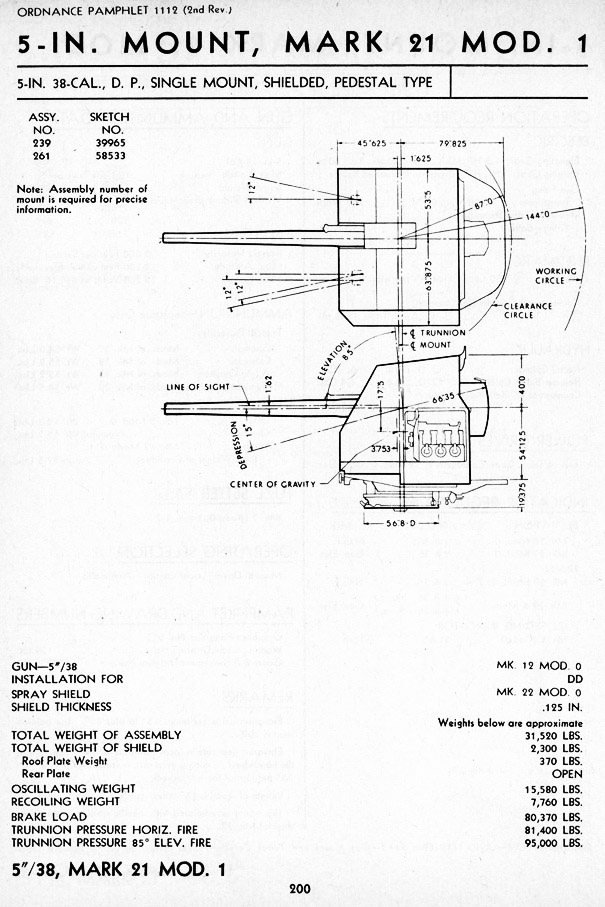
The 5 inch guns were similar to the Previous Mahans, featuring an all-angle power loading, and were director controlled to the best against aircraft of the 1936 generation (still biplanes). By late 1942 a great improvement was achieved by using radio proximity fuses for extra effectiveness. The two forward guns were in fully enclosed Mark 25 mounts, but the after guns were open, under shields, not fully enclosed Mark 21 DP pedestal mounts. The fully enclose mounts, the new destroyer standard, was tested on the last two of the previous Mahan class and proved successful.

Mark 25 Main gun mount
Specifications 5-in/38 Mk.12:
Max ROF 450, Practical 250-320, cyclic 900 rpm
Muzzle velocity 820 m/s (2,700 ft/s)
Effective range 914 m (1,000 yd)
Maximum firing range 45° 4,389 m (4,800 yd)
Read More
Torpedo Armament: 16x 21-in TTs
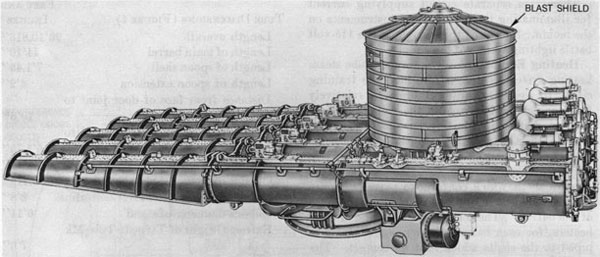
Planned initially in 1936 to carry Mark 11 and later Mark 12 torpedoes they obtained the promising Mark 15 in 1938 as the Bagleys and Benham. One tactic suggested to use the new torpedoes was a “curved ahead fire”, using the adjustable post-launch gyro angle to launch a sixteen-torpedo spread ahead instead of a U-turn. It is not sure if this was practiced, or even used in action during the war. The Mark 15 anyway suffered from a mediocre reliability.
Mark 15 Torpedo Mod 0 specs:
Weight: 3,438 lbs. (1,55 kg) for 288 inches (7.3 meters)
Range: 6,000 yards at 45 knots (5,500 meters at 83 km/h) or 15,000 yards at 26.5 knots (13,500 meters at 49 km/h)
Warhead: TNT Mod.3 HBX 494 lbs. (224 kg), Detonation mechanism Mk 6 Mod 13 contact exploder
Engine: Wet-heater combustion/steam turbine with compressed air tank and Methanol 26.5/33.5/45 knots
Guidance system: Gyroscope
AA: Initial and wartime
In common with all US surface combatants in the 1930s, light AA armament was weak to say the last, ans the Gridleys were no exception, delivered in 1938 with just four .50 Browning heavy machine guns (12.7 mm). It was woefully inadequate as shown at Pearl Harbor. Soon all these ships were refitted with seven 20 mm Oerlikon cannon but due to stability reasons they receoved no 40 mm Bofors guns and kept their torpedo tubes, instead of additional light AA guns.
ASW armament
The Gridleys class came with the standard two depth charge racks aft. Drawings shows these had the capacity of eight depth charge each. Settings were done manually on the fly as the dial was accessible from the sides. Photographs shows a wartime augmentation of four K-gun depth charge throwers installed on either side abaft the aft superstructure, so eight in all.
Modifications
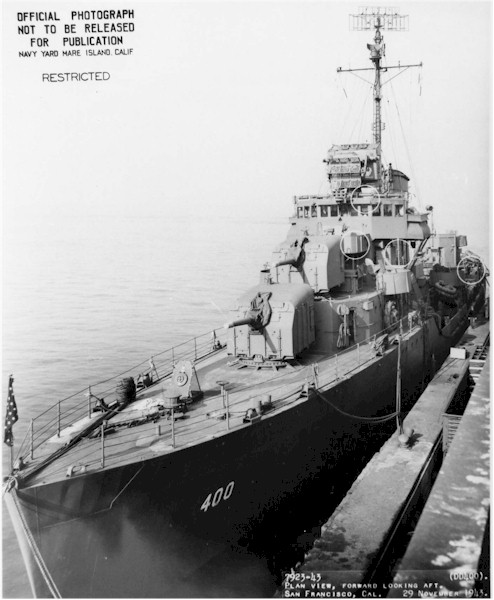
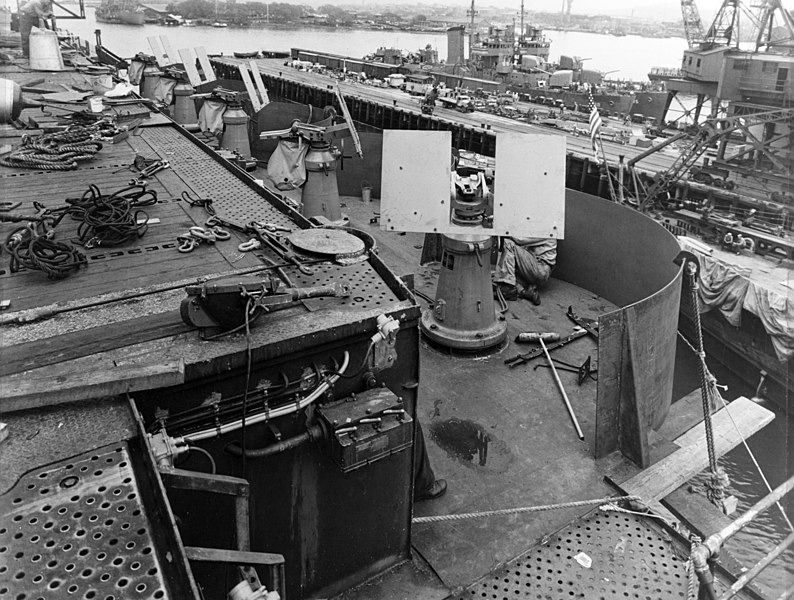
1944 Mare Island refit, USS Mac Call
By early 1942 they lost their four 0.5-in/90 HMGs but gained six 20mm/70 Mk 4 1942 and four Depth charges throwers (Y-guns) aft for 44 DC in all
Between 1942 and 1944 they gained a SC and a SG radars as well as a Mk 12.22 radar.
By mid-194 they all received an extra single 20mm/70 Mk 4 AA guns, and later USS Gridley, Craven, McCall received another extra 20mm/70 Mk 4 (so eight)
By the spring of 1945, all they all lost their two aft torpedo tubes banks. In 1946, DD380, 382 and 400 kept their two 127mm/38 Mk 25forward and two 127mm/38 Mk 21 gun mounts aft, eight 20mm/70 Mk 10, two TT banks, four DCTs and two DCR and a QCA sonar, added in between. It seems also that the bridge was modified, with portholes instead of the original fragile glasshouse.
Sensors: FCS, Radars and Sonars
Mark 33 gun fire-control system: For aerial targets moving at up to 320-400 knots for AA fire, Mark 4 FC radar added atop from 1942 or Mark 4 radar for 30-40,000 yards detection.
SC Radar: The GE SC had an “A” scope, IFF connection, gyro-compass repeater link, 30-75 miles ± 200 yards accuracy later ± 100 yds on the SC-1 whereas bearing accuracy was ± 5°.
220 kW Air/Surface-search radar (VHF band/60 Hz PRF), bmw 10–25°, psw 4–5.
SG Radar: 50 KW Surface Search Frq 3 GHz PRF 775/800/825, Bmwdt 5.6°/15°, Pwdt 1.3–2 μs RPM 4/8/12, Range 15 nmi @200 yd*
Mk 12.22 Radar: Medium Wave Fire Control for Dual Purpose Batteries, goes with the Mark 37 FC Director*
QCA sonar: Early type, spherical, underwater. Manufactured by CMB. 24 cycles frequenty, M/S spherical projector, 400 Watts, electric hoist and train*
Camouflage Liveries
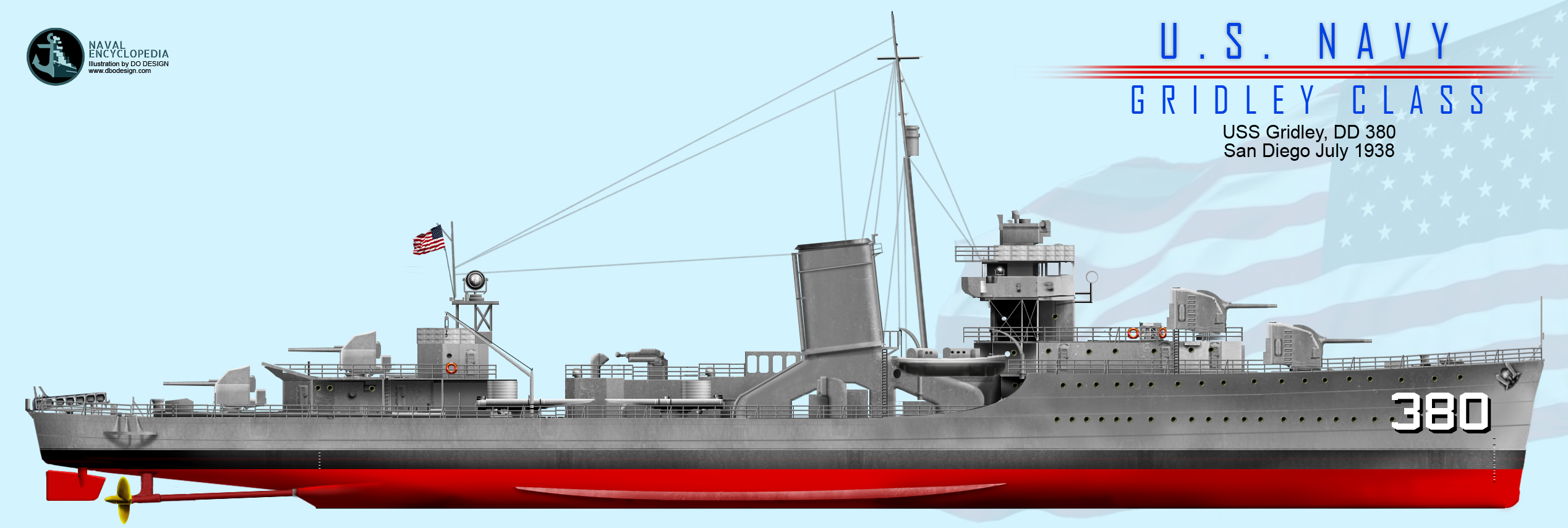
HD Illustration of USS Bagley in July 1938
⚙ specifications |
|
| Displacement | 1590 tons standard, 2219 tons full load |
| Dimensions | 340 ft 10 in x 35 ft 10 in x 12 ft 9 in (103.89 x 10.92 x 3.89 m) |
| Propulsion | 2 shafts Bethlehem Parsons GST, 4 Yarrow boilers 47,000 shp (35,000 kW) |
| Speed | 38.5 knots (71.3 km/h; 44.3 mph) |
| Range | 5,520 nautical miles (10,220 km; 6,350 mi) at 12 kn (22 km/h; 14 mph) |
| Armament | 4x 5-in/38 guns, 4×4 21-in TTs, 4x 0.5-in AA, 2×8 DCR |
| Sensors | Mk33 GFCS, SC, SG, Mk.12.22 radars, QCA sonar |
| Crew | 8 officers, 150 enlisted peacetime, 250 (wartime) |
General assessment
The large (but narrow) funnel for all four boilers was allowed by the fact these boilers produced a overheated steam, better than on the Mahan class and on a more compact machinery raise power without stretching the hull. Therefore the Gridleys were not only the fastest destroyers of the US Navy (DD-380 for example on trials, at 1,774t displacement managed 38.99kts and xxx 42 knots empty). But the FY1934 and FY1935 torpedo advantage was more a paper fantasy in the end than a practical solution in battle. They never really put an efficient tactic to maximize this. At the contrary this proved a liability given their unsufficient buoyancy and hull strength, and the end result was a stability not allowing much armament upgrade in wartime, nor significant modernization. This default was shared by the remainder of the Bagleys and Benhams. Wartime use did not put much more issue and they performed the best they could in much difficult times in the Pacific without loss. The class comprised one of the most decorated destroyers of the USN, in partucular the “record-breaker” Maury and her 16 battle stars, her sister earning respectively ten, nine and nine battle stars for a grand total of 44 battle stars.
Read More
Books
Bauer, K. Jack; Roberts, Stephen S. (1991). Register of Ships of the U.S. Navy 1775-1990. Greenwood Press
Friedman, Norman (2004). US Destroyers: An Illustrated Design History (Revised ed.). Annapolis NIP
Gardiner, Robert; Chesneau, Roger (1980). Conway’s All the World’s Fighting Ships 1922-1946. Conway Maritime Press.
Silverstone, Paul H. (1965). U.S. Warships of World War II. London: Ian Allan Ltd.
Public domain Dictionary of American Naval Fighting Ships.
Links
http://www.navsource.org/archives/05/386.htm
http://www.navsource.org/archives/05/382.htm
https://destroyerhistory.org/goldplater/1500ton/
https://destroyerhistory.org/goldplater/gridleyclass/
https://destroyerhistory.org/goldplater/index.asp?r=40100&pid=40190
https://destroyerhistory.org/assets/pdf/generalinformationbooks/380gridley_GIBook.pdf
https://www.history.navy.mil/our-collections/photography/us-navy-ships/alphabetical-listing/g/uss-gridley–dd-380-0.html
https://en.wikipedia.org/wiki/Gridley-class_destroyer
http://pwencycl.kgbudge.com/G/r/Gridley_class.htm
https://www.navypedia.org/ships/usa/us_dd_gridley.htm
https://alchetron.com/USS-Gridley-%28DD-380%29
https://commons.wikimedia.org/wiki/Category:Gridley_class_destroyers
Model Kits
Not super-inspiring to kit makers but anywway, here are a few examples:
USS Gridley DD-380 MidShip Models | No. MSM70001 | 1:700
A review of the USS Maury DD401 US Gridley class DD 1/350 Scale Resin Model Ship Kit by Iron Shipwrights
There is also a Comet 1:340. Full query on scalemates
 USS Gridley DD-380
USS Gridley DD-380
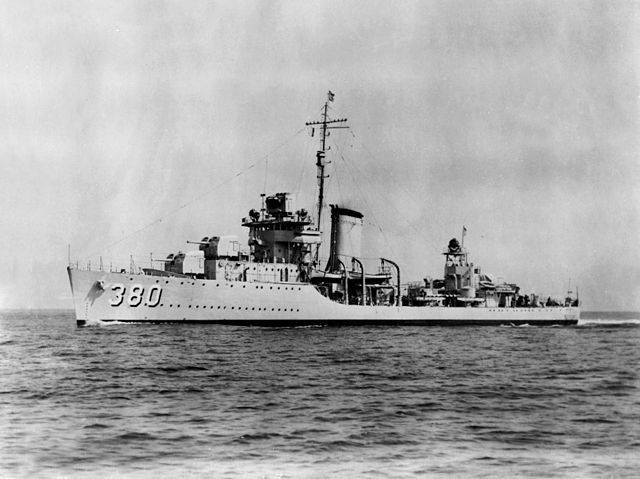
USS Gridley was commissioned 24 June 1937 with Codr. Leroy W. Busbey, Jr. in command, fitted out at Boston Navy Yard and after sea trials, making her shakedown cruise in the Caribbean until 27 October 1938. She notably stopped at Puerto Rico, Cuba, and in Venezuela. After post-fixes at Boston Navy Yard until June she was reassigned the Pacific, via the Panama Canal to San Diego and DesDiv 11, starting tactical maneuvers off California. By 4 January 1939 she was present in the Caribbean Fleet Problem 20 and returned for a quick refit in Boston.
On 13 July 1939 she became flagship of DesDiv 11. From 2 April 1940 she took part in Fleet Problem 21 off Hawaii.
She was out of Pearl Harbor on 28 November 1941, providing an ASW screen for USS Enterprise (Admiral Halsey), and resupplied at Wake before returning to Pearl Harbor when warned in the morning of the ongoing air raid. She entered the harbor on the 8th, expeting a new attack and spent the next five months escorting transports and repair vessels. On 5 June 1942 she was sent to Kodiak, Alaska, with USS Nashville. She escorted transports and patrolled off Kiska and Attu, also shelling the former on 7 August 1942, while under command of Frederick Moosbrugger.
She left Dutch Harbor on 25 September 1942 for USS Saratoga task force in Hawaii, and further escort mission to the Fijis and New Hebrides. December saw her escorting the oiler Cimarron from Noumea (later converted as a Sangamon class carrier) refuallung the carrier task forces in the Solomons. Based in Purvis Bay, Solomons from 13 July, she escorted fast transports rescuing survivors from USS Helena in Parasco Bay and with her sister USS Maury escorted the LCIs from Guadalcanal to Tambatuni in New Georgia. She shelled shore installations on the 25th and supported the landing. She also destroyed Japanese landing barges in Vella Gulf on 10 August and returned to USS Saratoga TF until 25 August.
Back to Pearl Harbor with USS Suwanee and USS Long Island on 4 September 1943 she returned to San Diego, for a refit (11 September-26 October 1943). She was reassigned to the Gilbert Islands after a stop at Pearl Harbor on 10 November and Makin Island. She bombarded the latter and screened the carriers before patrolling the area and was back to pearl afterwards in December.
TF 58 departed Pearl Harbor on 18 January 1944 for Marshall Islands Campaign, escorted by USS Gridley, always faithful to USS Saratoga. She was present at the attack of Wotje and Eniwetok, the New Hebrides in March, protecting Yorktown, Princeton and Langley and took part in the New Guinea offensive. She was reassigned to USS Hornet TF on 7 June 1944 for the invasion of the Marianas and attacks on Saipan, Rota, and Guam with her other three sisters.
She took part in the Battle of the Philippine Sea (19-20 June) and tried to protect the carriers with a antiaircraft fire. She departed Eniwetok Atoll on 30 June 1944 for new striked on Iwo Jima, Guam, Yap, Ulithi and supported landings on Peleliu (15 September), claiming her first IJN attack plane. She screened TF 58 to Okinawa and Formosa and took part in the invasion of the Philippines. While in patrol off Luzon, 28 October 1944 with USS Helm she detected and sank I-51 with depth charges. Next days saw her repelling Japanese kamikazes. She escorted Franklin and Bellau Woods back to Ulithi on 2 November.
The last year of the war saw USS Gridley deployed in the Leyte landings, and screening escort carriers, used as bombardment and patrol ship off Lingayen Gulf, until 10 February.
After a last stop at Ulithi she escorted USS Mississippi back to Pearl Harbor, sailed to San Diego and crossed the Canal to New York, arriving on 30 March 1945 for her last overhaul. She was done on 22 June 1945 but was sent in Europe from July 1945 to January 1946. USS Gridley was eventually decommissioned in Boston on 18 April 1946 and sold, scrapped in 1947. She won 10 battle stars for her service.
 USS Craven DD-382
USS Craven DD-382
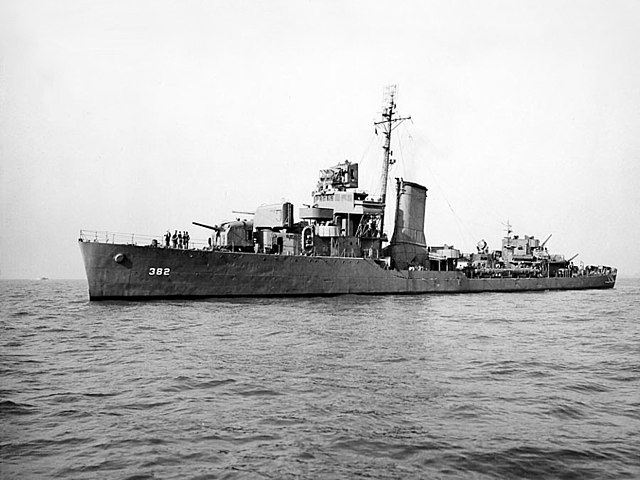
USS Craven was commissioned on 2 September 1937 and after trials, shakedown and training in the Caribbean she started fleet training along the east coast but also experimental torpedo firing at Newport, Rhode Island (notably the new tactics developed for these ships, enabling a double launch in short time). She sailed from Norfolk on 16 August 1938 for the Pacific fleet at San Diego and too part in fleet problems 20 and 21 alternated with ports visits, but remaining based on the west coast. By April 1940 she was in Pearl Harbor, tasked of ASW screen for carriers.
During the Pearl Harbor attack, she was out at sea screeing USS Enterprise to Wake Island and back to Pearl Harbor. She was was damaged when colliding with USS Northampton during underway refueling on 15 December, and battered by heavy seas on 19 December. So she was repaired at Pearl Harbor later.
USS Craven took part in the Marshalls and Gilberts offensives, Wake Island assault and was back home for an overhaul on the west coast. On 8 April she escorted convoys from the west coast and after a stop at Pearl Harbor on 12 November 1942 she headed for Guadalcanal, escorting transports in and out for nine months. By 6-7 August 1943 she was part of the Vella Gulf raid which destroyed the IJN Kawakaze, Hagikaze and Arashi also damaging a cruiser.
From Efate on 23 September 1943 she returned to an overhault in San Francisco, and was back to Pearl Harbor for more oprtations by January 1944, screening TF 58 carriers for the raids on Wotje, Taroa, and Eniwetok and the Marshall Islands campaign, base in Majuro. Next were the Palau, Yap, Ulithi, Woleai raids and invasion of Hollandia, raid on Truk, Satawan, and Ponape. Back to Pearl Harbor for a short refit in May 1944 she was back with the 5th Fleet for the Marianas Operations, Guam, Saipan, Rota, Bonins, and took part in June to the Battle of the Philippine Sea. She was present during the summer raids on the Bonins, Guam, Yap, and Palaus.
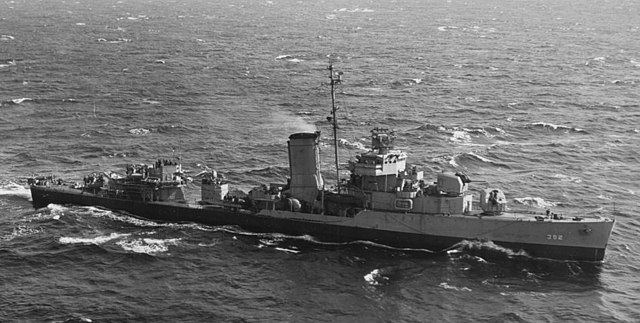
USS Craven in March 1945. She spent her last months of service in Europe, seeing the Atlantic and Mediterranean
She was overhauled a last time in Pearl Harbor by October 1944, missing the battle of Leyte. By January 1945 after retraining she was sent to New York via the west coast and Panama. There from 26 January she took part in exercises and ASW patrols on the east coast, until 2 May. She was sent to Europe, Southampton, escorting a convoy and back to NyC. Based in Portland, Maine, in she carried the U.S. Minister to Tangier and proceeded to Oran, escorting various ships in the Mediterranean and training until 14 January 1946. Sent back to New York, she headed for San Diego and Pearl Harbor (16 March) to be inactivated. She was decommissioned on 19 April 1946, sold for BU on 2 October 1947. She win nine battle stars for her service.
 USS McCall DD-400
USS McCall DD-400
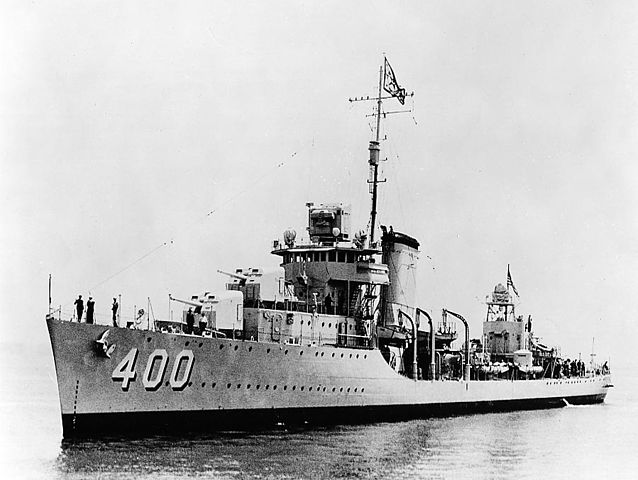
USS Mac Call in 1938
USS Mc Call was commissioned on 22 June 1938 with Lt. Cdr John Whelchel in command. After sea trials and Carribean shakedown she was assigned to the Pacific, and crossed Panama to San Diego, reporting to Destroyers, Battle Force, 16 January 1939. She took part in two fleet problems and by 7 December 1941, like her sisters she was screening one of the lucky carriers that day, escorting USS Enterprise (TF 8) en route to Pearl Harbor from Wake and started to search for the IJN fleet. Only I70 was sighted, sunk by aicraft on the 10th. She stayed with Enterprise expecting a follow-up attack.
USS McCall next screened Enterprise and Yorktown attacking Japanese positions in the southern Marshall Islands and northern Gilbert Islands on 1 February 1942, and were back to Oahu on 5 February. On the 15th the force rebaptised TF 16 headed for Wake and Marcus Islands for raids on 24 February and 4 March. 6 weeks patrolling Hawaiian waters and escort ships to Samoa, Fiji, and Tonga were followed by the Aleutian Islands operations. She operated off Kodiak, and bombarded the western Aleutians. She had an overhaul in pearl Harbor in November, and joined TF 11 for the Battle of Guadalcanal. She would stay 10 months in the Solomons, operating from Nouméa for escort work and ASW patrols. On 19 September 1943, she went home for the first time sibce the war started, joining a convoy back to San Francisco, having a new overhaul followed by a refresher exercises.
By January 1944 she joined TF 58 for the Wotje, Taroa, and Eniwetok raids of February. By March, this was Palau, Majuro, Yap, Ulithi, and Woleai, up to 1st April. She also covered landings at Hollandia as well as the raids of Truk, Satawan, and Ponape until 1st May. After workout and rest at Pearl Harbor, she operated off Majuro on 4 June and took part in the Marianas compaigns, being present dueing the landings on Guam, Rota, and Saipan. On 19 June she saw the Battle of the Philippine Sea and she was sent in the pursuit force against the IJN carriers, before returning to the screens and the Bonins raid; She had some rest and resupply at Eniwetok (from 27 June).
On 4 July, she screend the carriers raidng Iwo Jima. Next, USS McCall patrolled off Guam and on 10 July, 18:20 she spotted a heliograph from a cliff south of Uruno Point and sent a boatd to rescue the man, still within range of 6 in (152 mm) coastal batteries. This was George R. Tweed, RM1c, stranded on Guam since 1939, hiding from the Japanese His intel were vital for the next operations.
For nine weeks she screened the carriers striking again at Iwo Jima, Palaus, Yap, and Ulithi. On 10 October she steamed from Okinawa to Formosa and Luzon. Next she took part in the Battle of Leyte Gulf.
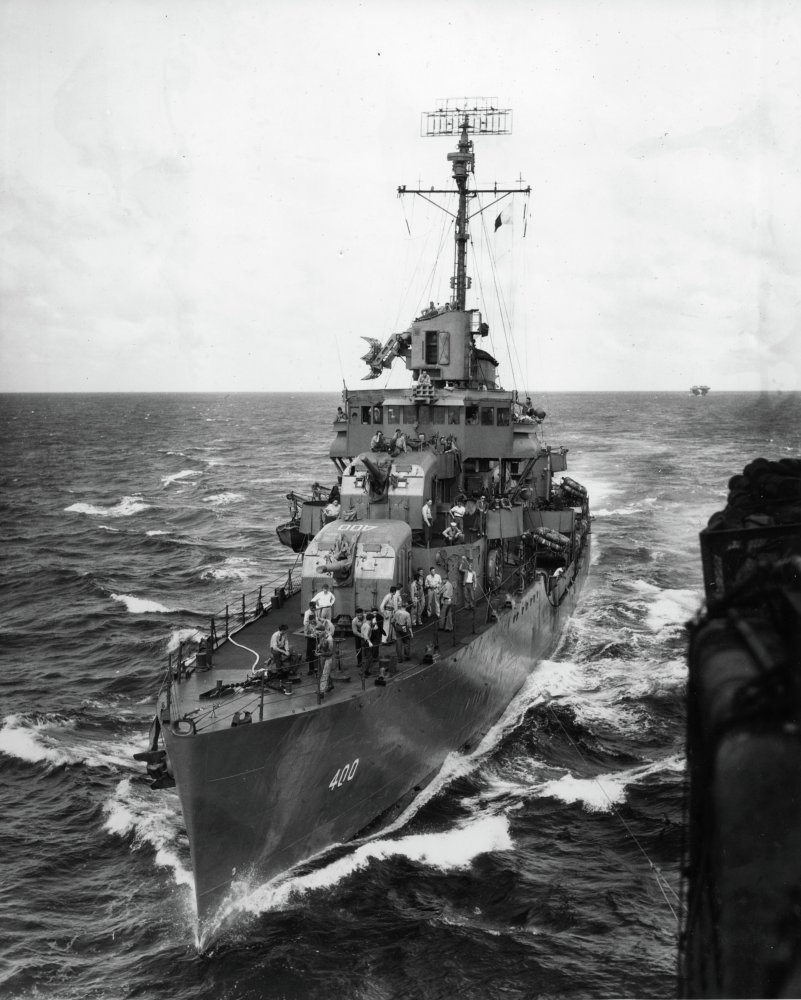
Mc Call underway 15 Jan 1945
USS McCall in November patrolled off Leyte and rested/resupplied at Manus. On 27 December she headed for Lingayen Gulf and the Luzon invasion. By mid-January 1945 she was reassigned to TG 78.12, escorting transports, alternated with fire support. By 19 February she arrived off Iwo Jima and took part in the battle until March, then escorted transports and provding on-demand shore bombardment, night illumination for the Marines. On 27 March she headed for the Volcano Islands area, Pearl Harbor and San Diego on 22 April, Panama, and an overhaul at New York NyD completed on 4 August. She was doing her refresher training at Casco Bay when the war ended.
In November she entered Norfolk Navy Yard for decommission on 30 November 1945, mothballed; and finally stricken on 28 January 1947, sold in November, scrapped in March 1948. Her service won her nine battle stars.
 USS Maury DD-401
USS Maury DD-401
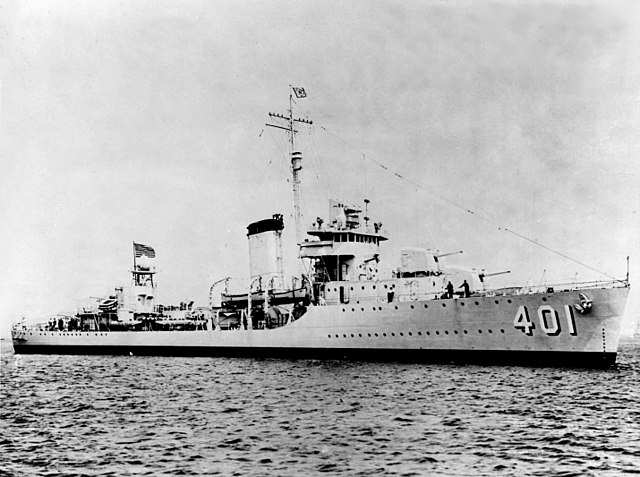
USS Maury as completed in mid-1938
Commissioned on 5 August 1938, USS Maury borke all records for her speed trials, by reaching 42.8 knots, but both with no ammo and minimal load, including just enough oil to perform the deed. She proved the USN the Bethlehem design capabilities. In practice she rarely again reached 36 knots. After Carribean shakedown and fleet problem, she was sent to the Pacific, Pearl Harbor, like her sisters screening USS Enterprise (TF 8) coming back from Wake and started a search of the IJN fleet, learning about the sinking of I-70 on 10 December.
In Jan-February she screened CV-6 for the raids on Maleolap Atoll, Taroa, and Reuters. Now reassigned to TF 16 she took part in the Wake and Marcus Islands raids, alternated with free ASW patrols. Back at Ohau she took part in antiaircraft exercises, and performed offshore patrol. On 30 April 1942 still with TF 16, Yorktown and Lexington, she took part in the Battle of the Coral Sea. She took part in the Battle of Midway with TF 17 on 4 June.
In later July she took part in the Tonga Islands sortie to the Solomons and the start of Operations on 7 August at Guadalcanal. She screened Enterprise and was present at the Battle of the Eastern Solomons, on the 24-25th. This saw USS Enteprise very severely damaged and USS Maury escorted her to Tonga Islands and Pearl Harbor, arriving on 10 September. On 26 October, she was present at the Battle of Santa Cruz witnessing the loss of USS Hornet.
For 10 months with DesDiv 11 she operated in the Solomons from Nouméa and Espiritu Santo, between escort and ASW patrols. She saw the raids on Munda, Rendova, Russell, Vella Lavella, and New Georgia.
Her most important personal operation was under Captain Frederick Moosbrugger’s Task Group 31.2: The Battle of Vella Gulf, 6–7 August 1943 with her sisters USS Craven, and Dunlap. The daring raid was a surprise torpedo attack on IJN destroyers anchored there, sinking Hagikaze, Arashi, and Kawakaze. This was the first successful USN night torpedo engagement, a tasted of their own medecine for the Japanese. Later in August 1943, she departed for San Pedro and a 6-week overhaul before returning to TF 52 to and operations of Tarawa and Makin (Gilbert Islands Campaign) up to late November.
In Jan-Feb. 1944 USS Maury was back to screen carriers with TF 58 for the raids of Wotje, Taroa, Eniwetok, and Palau Islands. In March she was relocated to Majuro and assisted the raids on the Palaus, Yap, Ulithi, and Woleai, landings at Hollandia, raids on Ponape, Satawan, and Truk.
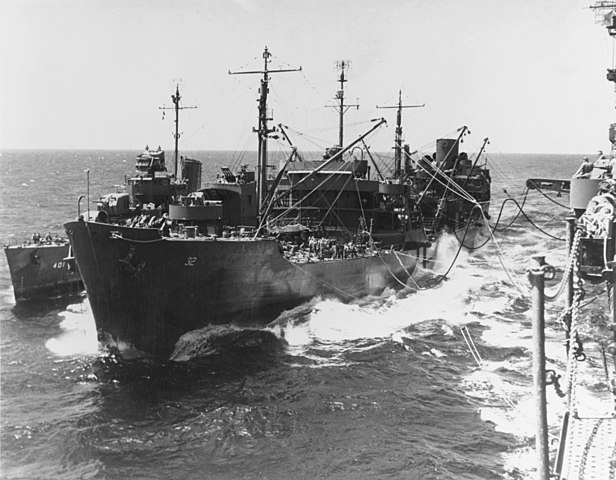
USS Maury resupplied by USS Guadalupe (AO-32) as well as USS Lexington in November 1943
After a short refit at Pearl Harbor, she was back to TF 58 and present at Majuro on 4 June, then udnerway for the Marianas Islands. She bombarded Saipan, and screened the raids on Guam and Rota, and later Iwo and Chichi Jima. On 19 June she was present during the Battle of the Philippine and later Saipan operations. It was followed by the Bonins raid, until rest and resupply to Eniwetok from 27 June.
On 4 July, she was present during the raid at Iwo Jima, the landings on Guam and Tinian and for 9 weeks, she was with the carrier screen, striking Iwo Jima and be present for the offensive Peleliu, Ngesebu, Angaur, Yap, and Ulithi, Formosa and Luzon, Manila Bay and Leyte Gulf, and the battle at Cape Engaño.
By November she patrolled east of the Philippines for the Leyte and Samar landings and operations. After a resupply at Manus she was reassigned to TG 77.4 in December for the Lingayen Gulf and Luzon invasion, then TG 78.12 in January 1945 for convoy escort and TF 77 until 10 February 1945 in Lingayen Gulf. After a stop to Ulithi on 16 February she escorted with a sister USS Mississippi back to Pearl Harbor on 3 April.
For 6 weeks she performed training in Hawaiian waters, then departed for San Diego, crossed the Panama and entered New York Harbor and its Yard on 14 June for an overhaul, but the inspection team declared she would be more fitting to have her disposed of instead given her general state. On 18 August she was sent to Philadelphia for decommission on 19 October 1945, the first of the four destroyers to leave operations for good. Stricken on 1 November 1945, she was sold on 13 June 1946, resold and scrapped later. She won 16 battle stars and an Presidential Unit Citation, entering the conveted top ten of the most decorated US warships of this war.

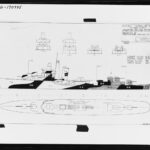
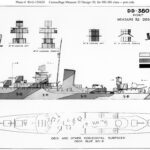
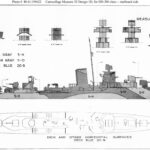
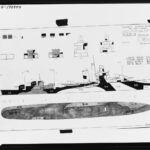
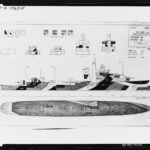
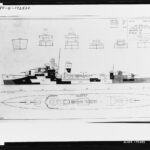
 Latest Facebook Entry -
Latest Facebook Entry -  X(Tweeter) Naval Encyclopedia's deck archive
X(Tweeter) Naval Encyclopedia's deck archive Instagram (@navalencyc)
Instagram (@navalencyc)





 French Navy
French Navy Royal Navy
Royal Navy Russian Navy
Russian Navy Armada Espanola
Armada Espanola Austrian Navy
Austrian Navy K.u.K. Kriegsmarine
K.u.K. Kriegsmarine Dansk Marine
Dansk Marine Nautiko Hellenon
Nautiko Hellenon Koninklije Marine 1870
Koninklije Marine 1870 Marinha do Brasil
Marinha do Brasil Osmanlı Donanması
Osmanlı Donanması Marina Do Peru
Marina Do Peru Marinha do Portugal
Marinha do Portugal Regia Marina 1870
Regia Marina 1870 Nihhon Kaigun 1870
Nihhon Kaigun 1870 Preußische Marine 1870
Preußische Marine 1870 Russkiy Flot 1870
Russkiy Flot 1870 Svenska marinen
Svenska marinen Søværnet
Søværnet Union Navy
Union Navy Confederate Navy
Confederate Navy Armada de Argentina
Armada de Argentina Imperial Chinese Navy
Imperial Chinese Navy Marinha do Portugal
Marinha do Portugal Mexico
Mexico Kaiserliche Marine
Kaiserliche Marine 1898 US Navy
1898 US Navy Sovietskiy Flot
Sovietskiy Flot Royal Canadian Navy
Royal Canadian Navy Royal Australian Navy
Royal Australian Navy RNZN Fleet
RNZN Fleet Chinese Navy 1937
Chinese Navy 1937 Kriegsmarine
Kriegsmarine Chilean Navy
Chilean Navy Danish Navy
Danish Navy Finnish Navy
Finnish Navy Hellenic Navy
Hellenic Navy Polish Navy
Polish Navy Romanian Navy
Romanian Navy Turkish Navy
Turkish Navy Royal Yugoslav Navy
Royal Yugoslav Navy Royal Thai Navy
Royal Thai Navy Minor Navies
Minor Navies Albania
Albania Austria
Austria Belgium
Belgium Columbia
Columbia Costa Rica
Costa Rica Cuba
Cuba Czechoslovakia
Czechoslovakia Dominican Republic
Dominican Republic Haiti
Haiti Hungary
Hungary Honduras
Honduras Estonia
Estonia Iceland
Iceland Eire
Eire Equador
Equador Iran
Iran Iraq
Iraq Latvia
Latvia Liberia
Liberia Lithuania
Lithuania Mandchukuo
Mandchukuo Morocco
Morocco Nicaragua
Nicaragua Persia
Persia San Salvador
San Salvador Sarawak
Sarawak Uruguay
Uruguay Venezuela
Venezuela Zanzibar
Zanzibar Warsaw Pact Navies
Warsaw Pact Navies Bulgaria
Bulgaria Hungary
Hungary

 Bundesmarine
Bundesmarine Dutch Navy
Dutch Navy Hellenic Navy
Hellenic Navy Marina Militare
Marina Militare Yugoslav Navy
Yugoslav Navy Chinese Navy
Chinese Navy Indian Navy
Indian Navy Indonesian Navy
Indonesian Navy JMSDF
JMSDF North Korean Navy
North Korean Navy Pakistani Navy
Pakistani Navy Philippines Navy
Philippines Navy ROKN
ROKN Rep. of Singapore Navy
Rep. of Singapore Navy Taiwanese Navy
Taiwanese Navy IDF Navy
IDF Navy Saudi Navy
Saudi Navy Royal New Zealand Navy
Royal New Zealand Navy Egyptian Navy
Egyptian Navy South African Navy
South African Navy






























 Ukrainian Navy
Ukrainian Navy dbodesign
dbodesign